Report on Wi-Fi Technology Vulnerabilities in HSBC Bank Network
VerifiedAdded on 2023/06/11
|18
|5079
|351
Report
AI Summary
This report identifies and analyzes the issues related to Wi-Fi technology within HSBC Bank, focusing on vulnerabilities that could lead to data theft, network disruptions, and unauthorized access. It discusses problems such as theft of user details, cracking of Wi-Fi networks, data theft through spoofing, and denial-of-service attacks. The report also addresses security problems associated with 802.11 WLANs, including eavesdropping and session hijacking. Furthermore, it highlights the challenges of maintaining fast media streaming over Wi-Fi due to low data transfer rates. The document proposes a solution centered on implementing WPA-Enterprise (WPA-802.1x, RADIUS) for enhanced wireless network security, offering personalized and centralized controls over Wi-Fi access. It emphasizes the importance of proper authentication methods and encryption to protect sensitive data and prevent unauthorized access to the bank's network. Desklib provides access to this and other student-contributed assignments.
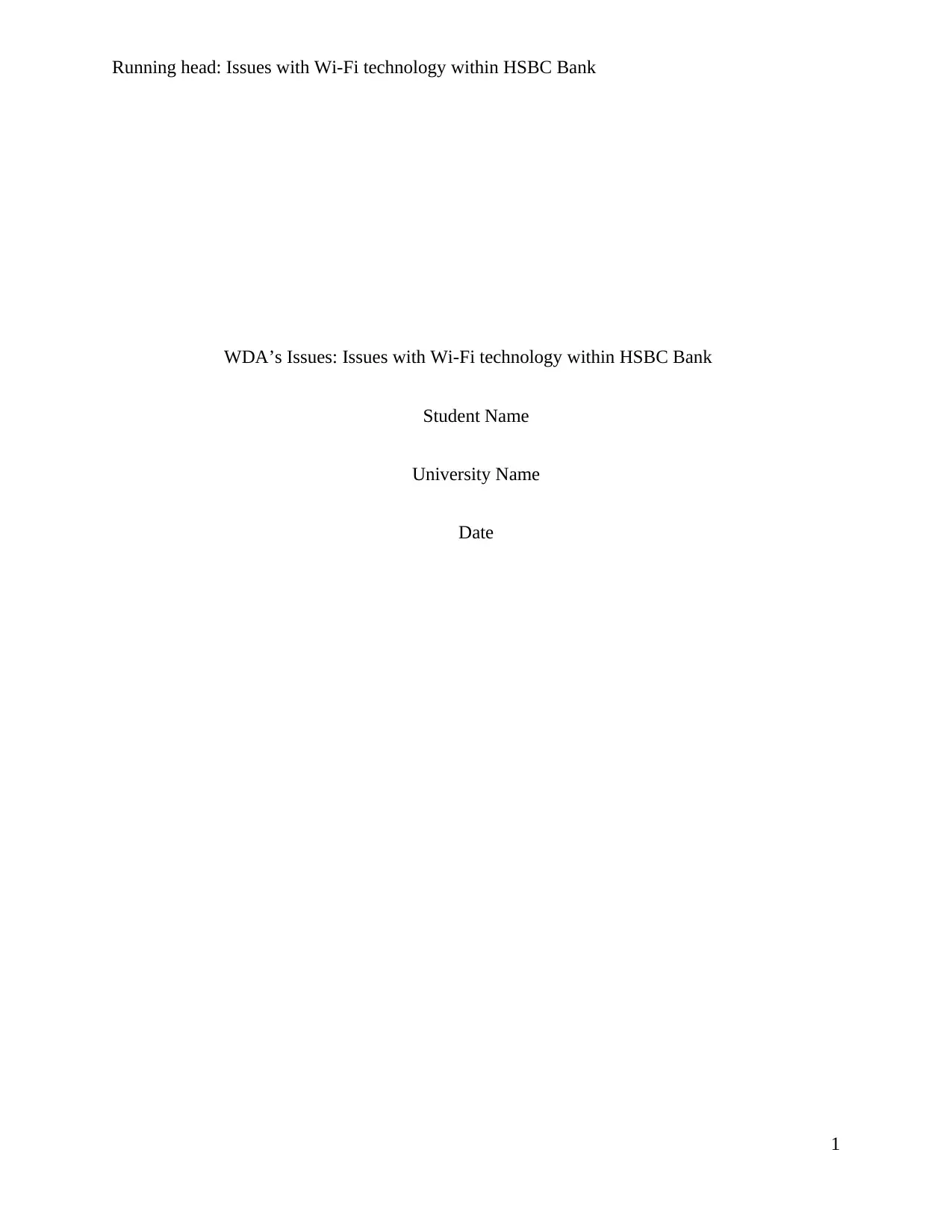
Running head: Issues with Wi-Fi technology within HSBC Bank
WDA’s Issues: Issues with Wi-Fi technology within HSBC Bank
Student Name
University Name
Date
1
WDA’s Issues: Issues with Wi-Fi technology within HSBC Bank
Student Name
University Name
Date
1
Paraphrase This Document
Need a fresh take? Get an instant paraphrase of this document with our AI Paraphraser
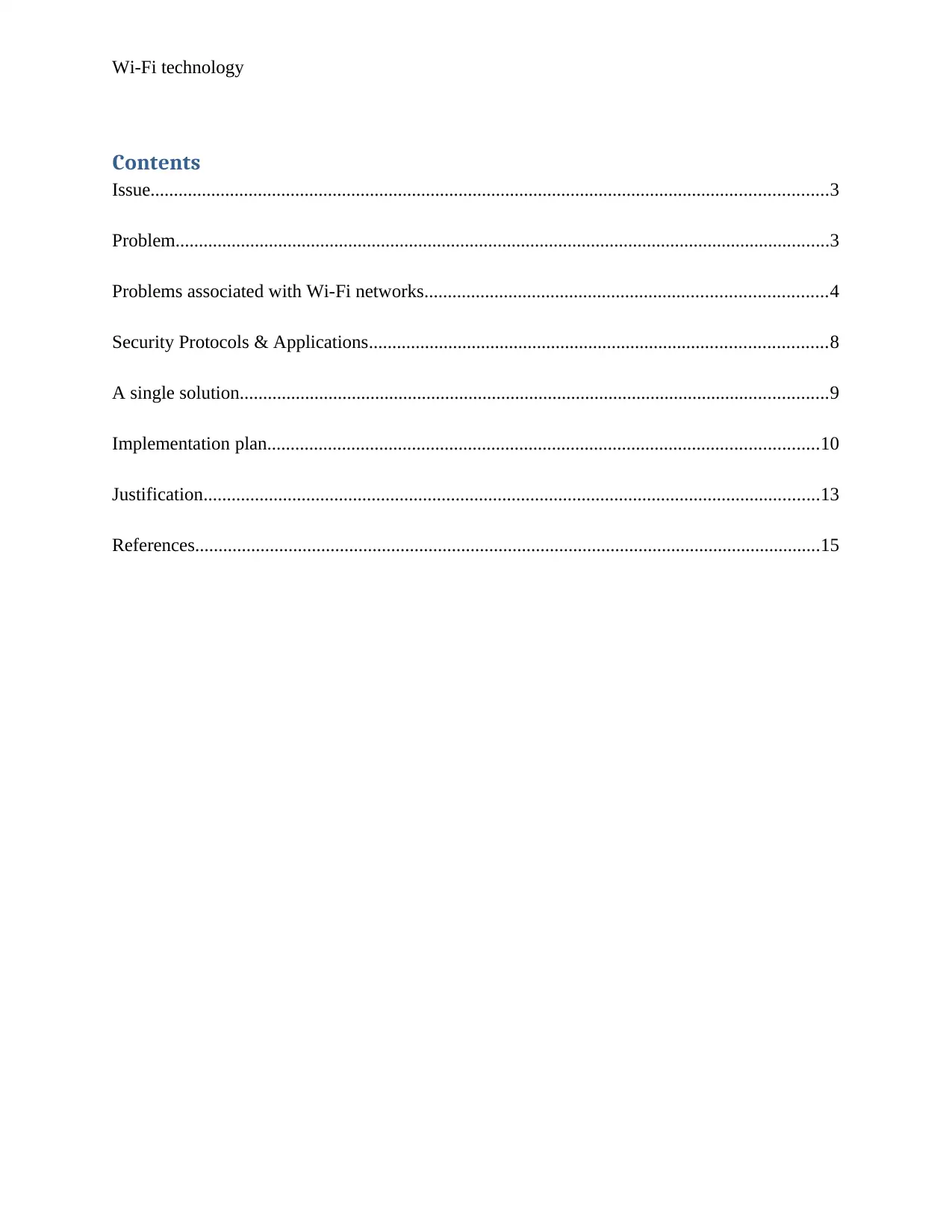
Wi-Fi technology
Contents
Issue.................................................................................................................................................3
Problem............................................................................................................................................3
Problems associated with Wi-Fi networks......................................................................................4
Security Protocols & Applications..................................................................................................8
A single solution..............................................................................................................................9
Implementation plan......................................................................................................................10
Justification....................................................................................................................................13
References......................................................................................................................................15
Contents
Issue.................................................................................................................................................3
Problem............................................................................................................................................3
Problems associated with Wi-Fi networks......................................................................................4
Security Protocols & Applications..................................................................................................8
A single solution..............................................................................................................................9
Implementation plan......................................................................................................................10
Justification....................................................................................................................................13
References......................................................................................................................................15

Wi-Fi technology
Issues: Issues with Wi-Fi technology within HSBC Bank
Increasing technology makes it easier for HSBC bank to use multiple technologies (such as
wireless, cloud, big data, and other technologies) to effectively run their business. These wireless
devices can be easily implemented within the Bank at a very low cost. Several bank’s have their
personal wireless LAN technology system (Ramesh & Pallam Setty, 2014). Bank has a wireless
network communication for performing its operations, for example, WLAN, 802.11 wirelesses
Ethernet for a WAN (Wide Area Network). This wireless network is also standardized by IEEE
802.11b/g Wi-Fi (wireless fidelity). In HSBC, several business operations are performed on a
wireless network, for example, sending E-mails and transferring a file over the Wi-Fi network.
But these facilities also bring some major issues for the bank because intruders or attackers
might gain access to bank’s customer’s documents and can inject malicious code into the files
and compromise bank’s network by accessing confidential files (Ramesh & Pallam Setty, 2014).
There are several issues that need to be addressed when implementing wireless network
communications within a company association, for example, security standard, server database
accessibilities, and more stages of encryptions to increase security or monitor regularly. There
are various tools available in the market with which detects the issue if any hacker hacks the
wireless networks, such as Kismet, an 802.11 wireless network detector “NetStumbler” which is
an 802.11b wireless LAN detector, and the WLAN and WireShark 802.11g standard for
analyzing networks (Izhar & R. Singh, 2014).
Issues: Issues with Wi-Fi technology within HSBC Bank
Increasing technology makes it easier for HSBC bank to use multiple technologies (such as
wireless, cloud, big data, and other technologies) to effectively run their business. These wireless
devices can be easily implemented within the Bank at a very low cost. Several bank’s have their
personal wireless LAN technology system (Ramesh & Pallam Setty, 2014). Bank has a wireless
network communication for performing its operations, for example, WLAN, 802.11 wirelesses
Ethernet for a WAN (Wide Area Network). This wireless network is also standardized by IEEE
802.11b/g Wi-Fi (wireless fidelity). In HSBC, several business operations are performed on a
wireless network, for example, sending E-mails and transferring a file over the Wi-Fi network.
But these facilities also bring some major issues for the bank because intruders or attackers
might gain access to bank’s customer’s documents and can inject malicious code into the files
and compromise bank’s network by accessing confidential files (Ramesh & Pallam Setty, 2014).
There are several issues that need to be addressed when implementing wireless network
communications within a company association, for example, security standard, server database
accessibilities, and more stages of encryptions to increase security or monitor regularly. There
are various tools available in the market with which detects the issue if any hacker hacks the
wireless networks, such as Kismet, an 802.11 wireless network detector “NetStumbler” which is
an 802.11b wireless LAN detector, and the WLAN and WireShark 802.11g standard for
analyzing networks (Izhar & R. Singh, 2014).
⊘ This is a preview!⊘
Do you want full access?
Subscribe today to unlock all pages.

Trusted by 1+ million students worldwide
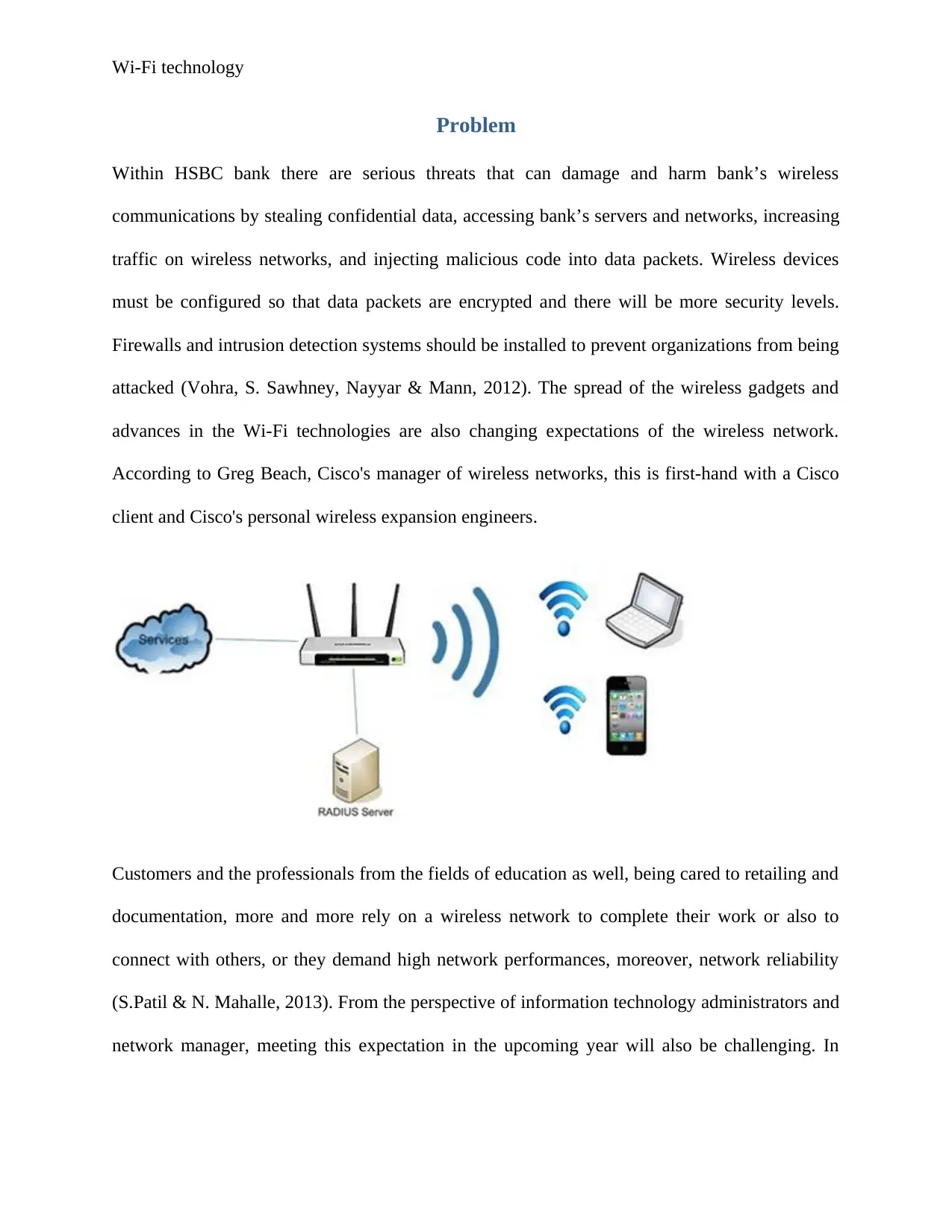
Wi-Fi technology
Problem
Within HSBC bank there are serious threats that can damage and harm bank’s wireless
communications by stealing confidential data, accessing bank’s servers and networks, increasing
traffic on wireless networks, and injecting malicious code into data packets. Wireless devices
must be configured so that data packets are encrypted and there will be more security levels.
Firewalls and intrusion detection systems should be installed to prevent organizations from being
attacked (Vohra, S. Sawhney, Nayyar & Mann, 2012). The spread of the wireless gadgets and
advances in the Wi-Fi technologies are also changing expectations of the wireless network.
According to Greg Beach, Cisco's manager of wireless networks, this is first-hand with a Cisco
client and Cisco's personal wireless expansion engineers.
Customers and the professionals from the fields of education as well, being cared to retailing and
documentation, more and more rely on a wireless network to complete their work or also to
connect with others, or they demand high network performances, moreover, network reliability
(S.Patil & N. Mahalle, 2013). From the perspective of information technology administrators and
network manager, meeting this expectation in the upcoming year will also be challenging. In
Problem
Within HSBC bank there are serious threats that can damage and harm bank’s wireless
communications by stealing confidential data, accessing bank’s servers and networks, increasing
traffic on wireless networks, and injecting malicious code into data packets. Wireless devices
must be configured so that data packets are encrypted and there will be more security levels.
Firewalls and intrusion detection systems should be installed to prevent organizations from being
attacked (Vohra, S. Sawhney, Nayyar & Mann, 2012). The spread of the wireless gadgets and
advances in the Wi-Fi technologies are also changing expectations of the wireless network.
According to Greg Beach, Cisco's manager of wireless networks, this is first-hand with a Cisco
client and Cisco's personal wireless expansion engineers.
Customers and the professionals from the fields of education as well, being cared to retailing and
documentation, more and more rely on a wireless network to complete their work or also to
connect with others, or they demand high network performances, moreover, network reliability
(S.Patil & N. Mahalle, 2013). From the perspective of information technology administrators and
network manager, meeting this expectation in the upcoming year will also be challenging. In
Paraphrase This Document
Need a fresh take? Get an instant paraphrase of this document with our AI Paraphraser
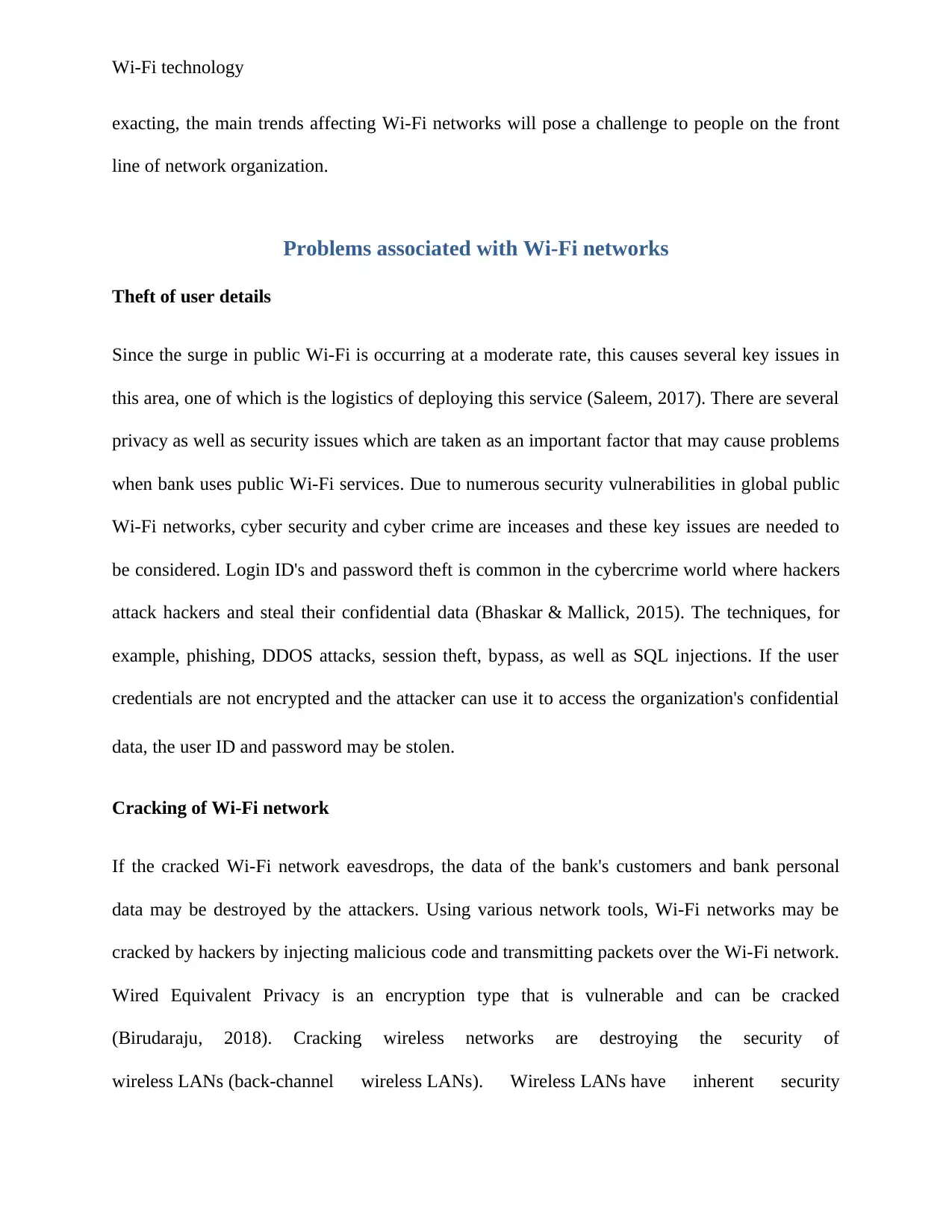
Wi-Fi technology
exacting, the main trends affecting Wi-Fi networks will pose a challenge to people on the front
line of network organization.
Problems associated with Wi-Fi networks
Theft of user details
Since the surge in public Wi-Fi is occurring at a moderate rate, this causes several key issues in
this area, one of which is the logistics of deploying this service (Saleem, 2017). There are several
privacy as well as security issues which are taken as an important factor that may cause problems
when bank uses public Wi-Fi services. Due to numerous security vulnerabilities in global public
Wi-Fi networks, cyber security and cyber crime are inceases and these key issues are needed to
be considered. Login ID's and password theft is common in the cybercrime world where hackers
attack hackers and steal their confidential data (Bhaskar & Mallick, 2015). The techniques, for
example, phishing, DDOS attacks, session theft, bypass, as well as SQL injections. If the user
credentials are not encrypted and the attacker can use it to access the organization's confidential
data, the user ID and password may be stolen.
Cracking of Wi-Fi network
If the cracked Wi-Fi network eavesdrops, the data of the bank's customers and bank personal
data may be destroyed by the attackers. Using various network tools, Wi-Fi networks may be
cracked by hackers by injecting malicious code and transmitting packets over the Wi-Fi network.
Wired Equivalent Privacy is an encryption type that is vulnerable and can be cracked
(Birudaraju, 2018). Cracking wireless networks are destroying the security of
wireless LANs (back-channel wireless LANs). Wireless LANs have inherent security
exacting, the main trends affecting Wi-Fi networks will pose a challenge to people on the front
line of network organization.
Problems associated with Wi-Fi networks
Theft of user details
Since the surge in public Wi-Fi is occurring at a moderate rate, this causes several key issues in
this area, one of which is the logistics of deploying this service (Saleem, 2017). There are several
privacy as well as security issues which are taken as an important factor that may cause problems
when bank uses public Wi-Fi services. Due to numerous security vulnerabilities in global public
Wi-Fi networks, cyber security and cyber crime are inceases and these key issues are needed to
be considered. Login ID's and password theft is common in the cybercrime world where hackers
attack hackers and steal their confidential data (Bhaskar & Mallick, 2015). The techniques, for
example, phishing, DDOS attacks, session theft, bypass, as well as SQL injections. If the user
credentials are not encrypted and the attacker can use it to access the organization's confidential
data, the user ID and password may be stolen.
Cracking of Wi-Fi network
If the cracked Wi-Fi network eavesdrops, the data of the bank's customers and bank personal
data may be destroyed by the attackers. Using various network tools, Wi-Fi networks may be
cracked by hackers by injecting malicious code and transmitting packets over the Wi-Fi network.
Wired Equivalent Privacy is an encryption type that is vulnerable and can be cracked
(Birudaraju, 2018). Cracking wireless networks are destroying the security of
wireless LANs (back-channel wireless LANs). Wireless LANs have inherent security
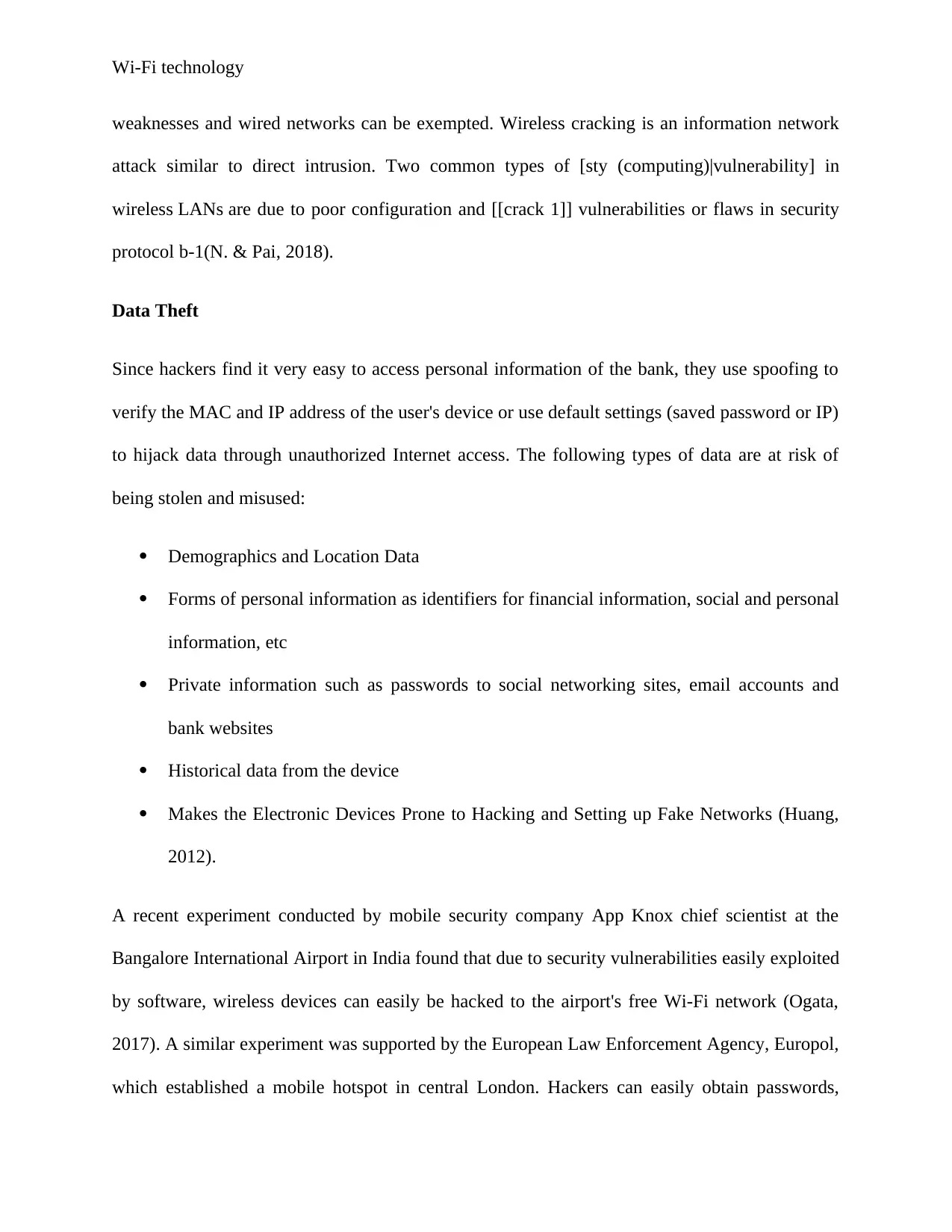
Wi-Fi technology
weaknesses and wired networks can be exempted. Wireless cracking is an information network
attack similar to direct intrusion. Two common types of [sty (computing)|vulnerability] in
wireless LANs are due to poor configuration and [[crack 1]] vulnerabilities or flaws in security
protocol b-1(N. & Pai, 2018).
Data Theft
Since hackers find it very easy to access personal information of the bank, they use spoofing to
verify the MAC and IP address of the user's device or use default settings (saved password or IP)
to hijack data through unauthorized Internet access. The following types of data are at risk of
being stolen and misused:
Demographics and Location Data
Forms of personal information as identifiers for financial information, social and personal
information, etc
Private information such as passwords to social networking sites, email accounts and
bank websites
Historical data from the device
Makes the Electronic Devices Prone to Hacking and Setting up Fake Networks (Huang,
2012).
A recent experiment conducted by mobile security company App Knox chief scientist at the
Bangalore International Airport in India found that due to security vulnerabilities easily exploited
by software, wireless devices can easily be hacked to the airport's free Wi-Fi network (Ogata,
2017). A similar experiment was supported by the European Law Enforcement Agency, Europol,
which established a mobile hotspot in central London. Hackers can easily obtain passwords,
weaknesses and wired networks can be exempted. Wireless cracking is an information network
attack similar to direct intrusion. Two common types of [sty (computing)|vulnerability] in
wireless LANs are due to poor configuration and [[crack 1]] vulnerabilities or flaws in security
protocol b-1(N. & Pai, 2018).
Data Theft
Since hackers find it very easy to access personal information of the bank, they use spoofing to
verify the MAC and IP address of the user's device or use default settings (saved password or IP)
to hijack data through unauthorized Internet access. The following types of data are at risk of
being stolen and misused:
Demographics and Location Data
Forms of personal information as identifiers for financial information, social and personal
information, etc
Private information such as passwords to social networking sites, email accounts and
bank websites
Historical data from the device
Makes the Electronic Devices Prone to Hacking and Setting up Fake Networks (Huang,
2012).
A recent experiment conducted by mobile security company App Knox chief scientist at the
Bangalore International Airport in India found that due to security vulnerabilities easily exploited
by software, wireless devices can easily be hacked to the airport's free Wi-Fi network (Ogata,
2017). A similar experiment was supported by the European Law Enforcement Agency, Europol,
which established a mobile hotspot in central London. Hackers can easily obtain passwords,
⊘ This is a preview!⊘
Do you want full access?
Subscribe today to unlock all pages.

Trusted by 1+ million students worldwide

Wi-Fi technology
applications, and even credit card and bank information. The lack of secure software and the
popularity of open, unprotected Wi-Fi make it easy for hackers to create virtual dual access
points that allow them to access data histories and personal information. This makes it easy to
track the user's data history. Even if some software uses an encryption code, Bank can use simple
decryption software to get the information (Lv, Ma, Li, Ma & Niu, 2011).
Disruption of Wi-Fi network
At this point, everyone should be very familiar with the concept of "rogue AP": the attacker
creates a seemingly innocent Wi-Fi access point, wants people to connect to it, and then makes
annoying things. The installation is simple and difficult for ordinary users to detect, and it is
becoming more and more common (Tomasek, 2014). But establishing an access point is just a
fight. Once set up, how do HSBC actually allow victims to connect to rogue wireless access
points? The attacker can give it an attractive name. If it is the only open access point in an area
with only encrypted networks, it may have a shot, but more often the client machine will connect
to any suitable network. , and ignore any other AP that may pop up. Wi-Fi networks can be
disrupted or disrupted by various attacks (such as DoS, session hijacking, or other attacks).
HSBC can delete sensitive records from the server, or by increasing the traffic on the entire
server, it may block the entire Wi-Fi network. Frame spoofing is one of the ways to attack the
wireless network, just like middleman attacks and session hijacking (Ben Abed, 2012).
Security problems with 802.11 WLAN
There are many security issues and risks in 802.11 wireless LANs, such as the use of
eavesdropping methods and network traffic analysis to destroy encryption keys. Many
802.11 LANs do not even provide any data integrity and authentication methods for data
applications, and even credit card and bank information. The lack of secure software and the
popularity of open, unprotected Wi-Fi make it easy for hackers to create virtual dual access
points that allow them to access data histories and personal information. This makes it easy to
track the user's data history. Even if some software uses an encryption code, Bank can use simple
decryption software to get the information (Lv, Ma, Li, Ma & Niu, 2011).
Disruption of Wi-Fi network
At this point, everyone should be very familiar with the concept of "rogue AP": the attacker
creates a seemingly innocent Wi-Fi access point, wants people to connect to it, and then makes
annoying things. The installation is simple and difficult for ordinary users to detect, and it is
becoming more and more common (Tomasek, 2014). But establishing an access point is just a
fight. Once set up, how do HSBC actually allow victims to connect to rogue wireless access
points? The attacker can give it an attractive name. If it is the only open access point in an area
with only encrypted networks, it may have a shot, but more often the client machine will connect
to any suitable network. , and ignore any other AP that may pop up. Wi-Fi networks can be
disrupted or disrupted by various attacks (such as DoS, session hijacking, or other attacks).
HSBC can delete sensitive records from the server, or by increasing the traffic on the entire
server, it may block the entire Wi-Fi network. Frame spoofing is one of the ways to attack the
wireless network, just like middleman attacks and session hijacking (Ben Abed, 2012).
Security problems with 802.11 WLAN
There are many security issues and risks in 802.11 wireless LANs, such as the use of
eavesdropping methods and network traffic analysis to destroy encryption keys. Many
802.11 LANs do not even provide any data integrity and authentication methods for data
Paraphrase This Document
Need a fresh take? Get an instant paraphrase of this document with our AI Paraphraser

Wi-Fi technology
security.
Denial of services: In this type of attack, intruders flood network with invalid and valid messages
that affect the availability of the network assets (Saffarian Eidgahi & Rafe, 2015). Due to nature
of transmissions radio, WLANs are vulnerable to the denial of a service attack. Radio
interference can be easily generated by using a transceiver that is powerful enough so that the
WLAN cannot communicate using the radio path (AL-Kadi, AL-Tuwaijri & AL-Omran, 2013).
Session furthermore spoofing hijacking these is where attackers may access restricted
information and assets on the network by assuming valid user identity. This happens because the
802.11 network doesn’t verify source addresses, which are the (MAC) address of a frame. The
attackers could thus spoof MAC address as well as hijack session. Additionally, 802.11 do not
need to access points to prove that they are actually an AP. These will facilitate an attacker who
can masquerade as an AP. When eliminate spoofing, appropriate authentication or access control
mechanism want to place in WLAN.
Lacking fast media streaming over Wi-Fi
Due to the low data transfer rate of the Wi-Fi network, it is a matter of concerns that the good
quality of the video stream could not be perfectly realized (Bhaskar & Mallick, 2015). If various
devices are also connected to every other, the bandwidth will allocate to a device that makes a
slower performance. It is not possible to perfectly view high-quality media files such as video
and audio.
Security Protocols & Applications
Increasing business needs to effectively use these wireless technologies in organizations. Wi-Fi
enabled devices such as wireless routers, satellite phones, PDAs, game consoles, operating
security.
Denial of services: In this type of attack, intruders flood network with invalid and valid messages
that affect the availability of the network assets (Saffarian Eidgahi & Rafe, 2015). Due to nature
of transmissions radio, WLANs are vulnerable to the denial of a service attack. Radio
interference can be easily generated by using a transceiver that is powerful enough so that the
WLAN cannot communicate using the radio path (AL-Kadi, AL-Tuwaijri & AL-Omran, 2013).
Session furthermore spoofing hijacking these is where attackers may access restricted
information and assets on the network by assuming valid user identity. This happens because the
802.11 network doesn’t verify source addresses, which are the (MAC) address of a frame. The
attackers could thus spoof MAC address as well as hijack session. Additionally, 802.11 do not
need to access points to prove that they are actually an AP. These will facilitate an attacker who
can masquerade as an AP. When eliminate spoofing, appropriate authentication or access control
mechanism want to place in WLAN.
Lacking fast media streaming over Wi-Fi
Due to the low data transfer rate of the Wi-Fi network, it is a matter of concerns that the good
quality of the video stream could not be perfectly realized (Bhaskar & Mallick, 2015). If various
devices are also connected to every other, the bandwidth will allocate to a device that makes a
slower performance. It is not possible to perfectly view high-quality media files such as video
and audio.
Security Protocols & Applications
Increasing business needs to effectively use these wireless technologies in organizations. Wi-Fi
enabled devices such as wireless routers, satellite phones, PDAs, game consoles, operating
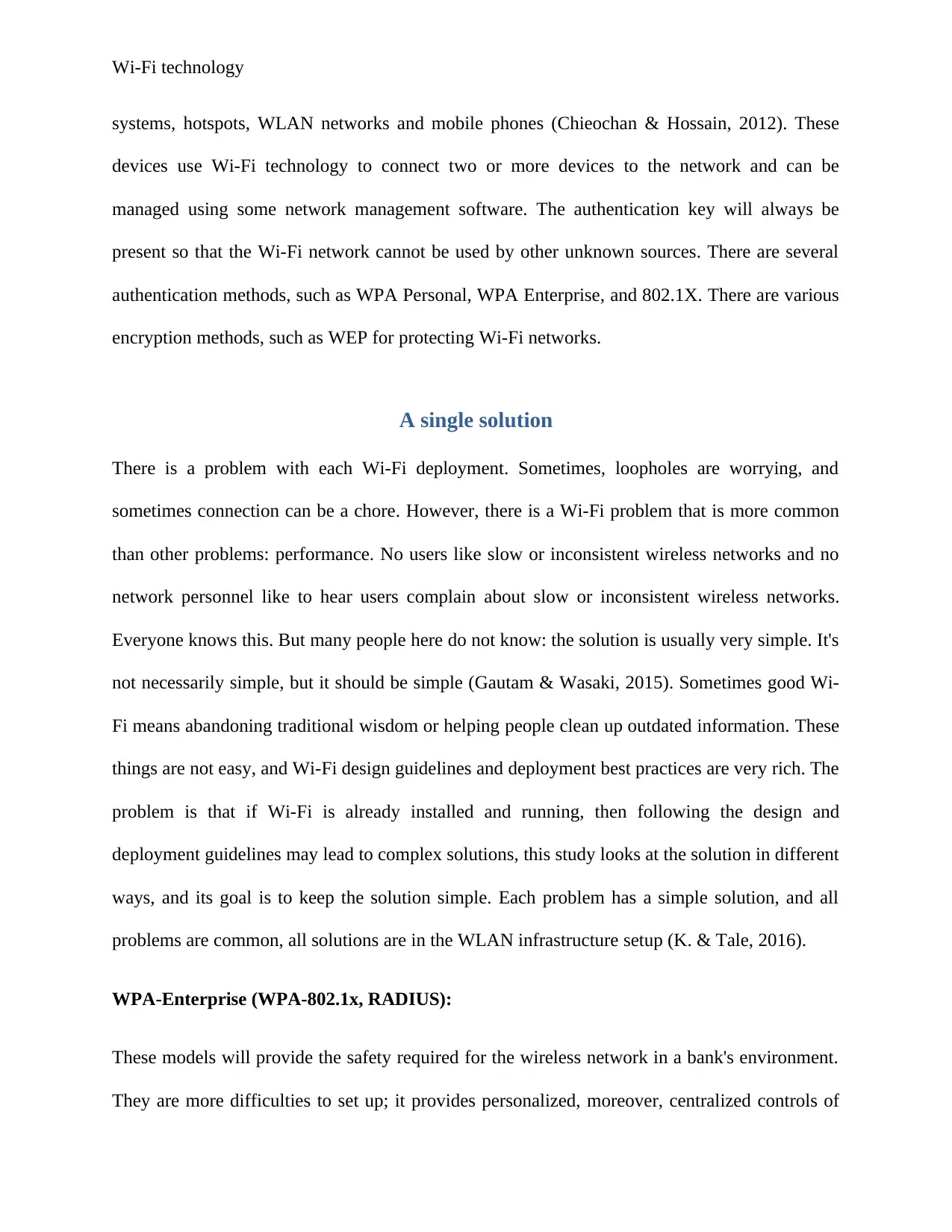
Wi-Fi technology
systems, hotspots, WLAN networks and mobile phones (Chieochan & Hossain, 2012). These
devices use Wi-Fi technology to connect two or more devices to the network and can be
managed using some network management software. The authentication key will always be
present so that the Wi-Fi network cannot be used by other unknown sources. There are several
authentication methods, such as WPA Personal, WPA Enterprise, and 802.1X. There are various
encryption methods, such as WEP for protecting Wi-Fi networks.
A single solution
There is a problem with each Wi-Fi deployment. Sometimes, loopholes are worrying, and
sometimes connection can be a chore. However, there is a Wi-Fi problem that is more common
than other problems: performance. No users like slow or inconsistent wireless networks and no
network personnel like to hear users complain about slow or inconsistent wireless networks.
Everyone knows this. But many people here do not know: the solution is usually very simple. It's
not necessarily simple, but it should be simple (Gautam & Wasaki, 2015). Sometimes good Wi-
Fi means abandoning traditional wisdom or helping people clean up outdated information. These
things are not easy, and Wi-Fi design guidelines and deployment best practices are very rich. The
problem is that if Wi-Fi is already installed and running, then following the design and
deployment guidelines may lead to complex solutions, this study looks at the solution in different
ways, and its goal is to keep the solution simple. Each problem has a simple solution, and all
problems are common, all solutions are in the WLAN infrastructure setup (K. & Tale, 2016).
WPA-Enterprise (WPA-802.1x, RADIUS):
These models will provide the safety required for the wireless network in a bank's environment.
They are more difficulties to set up; it provides personalized, moreover, centralized controls of
systems, hotspots, WLAN networks and mobile phones (Chieochan & Hossain, 2012). These
devices use Wi-Fi technology to connect two or more devices to the network and can be
managed using some network management software. The authentication key will always be
present so that the Wi-Fi network cannot be used by other unknown sources. There are several
authentication methods, such as WPA Personal, WPA Enterprise, and 802.1X. There are various
encryption methods, such as WEP for protecting Wi-Fi networks.
A single solution
There is a problem with each Wi-Fi deployment. Sometimes, loopholes are worrying, and
sometimes connection can be a chore. However, there is a Wi-Fi problem that is more common
than other problems: performance. No users like slow or inconsistent wireless networks and no
network personnel like to hear users complain about slow or inconsistent wireless networks.
Everyone knows this. But many people here do not know: the solution is usually very simple. It's
not necessarily simple, but it should be simple (Gautam & Wasaki, 2015). Sometimes good Wi-
Fi means abandoning traditional wisdom or helping people clean up outdated information. These
things are not easy, and Wi-Fi design guidelines and deployment best practices are very rich. The
problem is that if Wi-Fi is already installed and running, then following the design and
deployment guidelines may lead to complex solutions, this study looks at the solution in different
ways, and its goal is to keep the solution simple. Each problem has a simple solution, and all
problems are common, all solutions are in the WLAN infrastructure setup (K. & Tale, 2016).
WPA-Enterprise (WPA-802.1x, RADIUS):
These models will provide the safety required for the wireless network in a bank's environment.
They are more difficulties to set up; it provides personalized, moreover, centralized controls of
⊘ This is a preview!⊘
Do you want full access?
Subscribe today to unlock all pages.

Trusted by 1+ million students worldwide
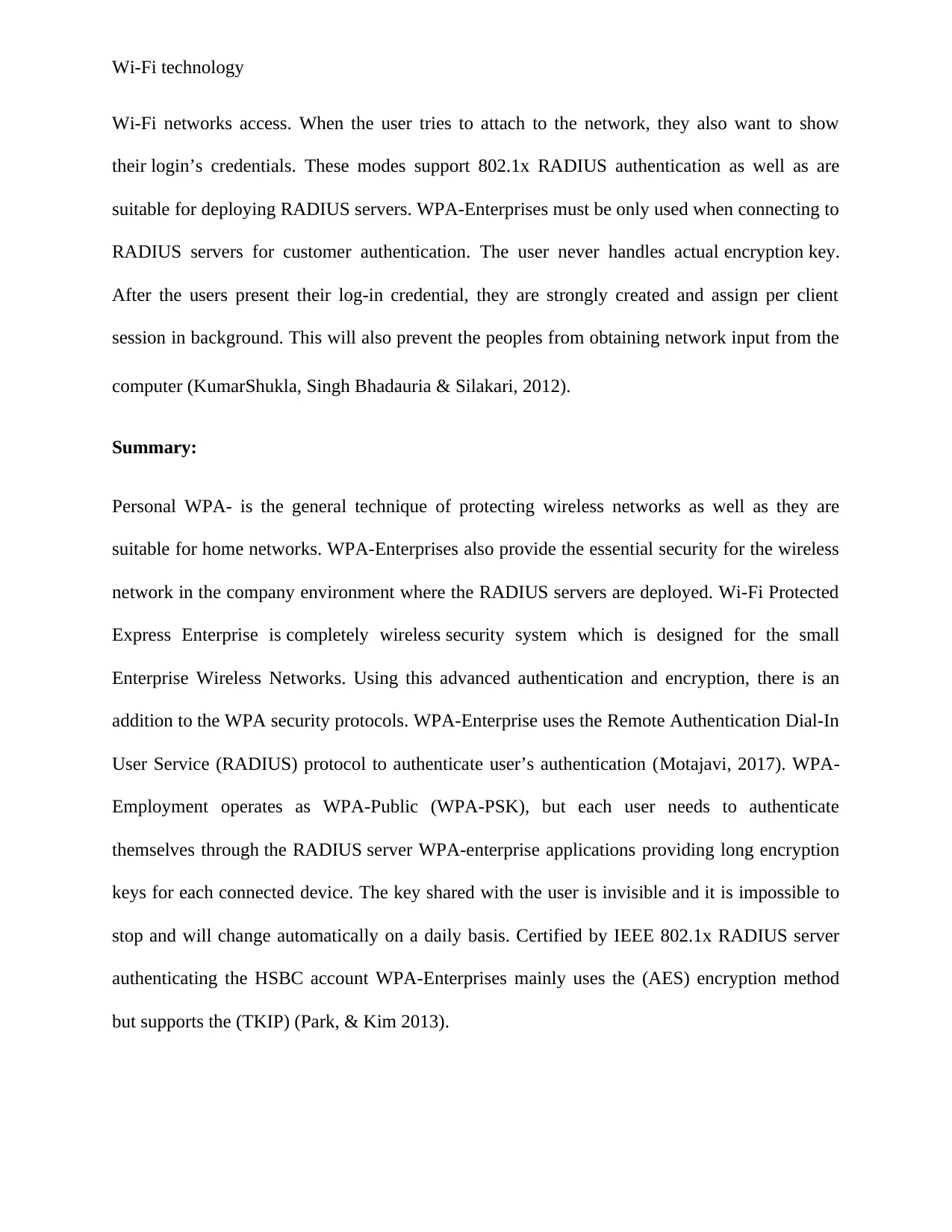
Wi-Fi technology
Wi-Fi networks access. When the user tries to attach to the network, they also want to show
their login’s credentials. These modes support 802.1x RADIUS authentication as well as are
suitable for deploying RADIUS servers. WPA-Enterprises must be only used when connecting to
RADIUS servers for customer authentication. The user never handles actual encryption key.
After the users present their log-in credential, they are strongly created and assign per client
session in background. This will also prevent the peoples from obtaining network input from the
computer (KumarShukla, Singh Bhadauria & Silakari, 2012).
Summary:
Personal WPA- is the general technique of protecting wireless networks as well as they are
suitable for home networks. WPA-Enterprises also provide the essential security for the wireless
network in the company environment where the RADIUS servers are deployed. Wi-Fi Protected
Express Enterprise is completely wireless security system which is designed for the small
Enterprise Wireless Networks. Using this advanced authentication and encryption, there is an
addition to the WPA security protocols. WPA-Enterprise uses the Remote Authentication Dial-In
User Service (RADIUS) protocol to authenticate user’s authentication (Motajavi, 2017). WPA-
Employment operates as WPA-Public (WPA-PSK), but each user needs to authenticate
themselves through the RADIUS server WPA-enterprise applications providing long encryption
keys for each connected device. The key shared with the user is invisible and it is impossible to
stop and will change automatically on a daily basis. Certified by IEEE 802.1x RADIUS server
authenticating the HSBC account WPA-Enterprises mainly uses the (AES) encryption method
but supports the (TKIP) (Park, & Kim 2013).
Wi-Fi networks access. When the user tries to attach to the network, they also want to show
their login’s credentials. These modes support 802.1x RADIUS authentication as well as are
suitable for deploying RADIUS servers. WPA-Enterprises must be only used when connecting to
RADIUS servers for customer authentication. The user never handles actual encryption key.
After the users present their log-in credential, they are strongly created and assign per client
session in background. This will also prevent the peoples from obtaining network input from the
computer (KumarShukla, Singh Bhadauria & Silakari, 2012).
Summary:
Personal WPA- is the general technique of protecting wireless networks as well as they are
suitable for home networks. WPA-Enterprises also provide the essential security for the wireless
network in the company environment where the RADIUS servers are deployed. Wi-Fi Protected
Express Enterprise is completely wireless security system which is designed for the small
Enterprise Wireless Networks. Using this advanced authentication and encryption, there is an
addition to the WPA security protocols. WPA-Enterprise uses the Remote Authentication Dial-In
User Service (RADIUS) protocol to authenticate user’s authentication (Motajavi, 2017). WPA-
Employment operates as WPA-Public (WPA-PSK), but each user needs to authenticate
themselves through the RADIUS server WPA-enterprise applications providing long encryption
keys for each connected device. The key shared with the user is invisible and it is impossible to
stop and will change automatically on a daily basis. Certified by IEEE 802.1x RADIUS server
authenticating the HSBC account WPA-Enterprises mainly uses the (AES) encryption method
but supports the (TKIP) (Park, & Kim 2013).
Paraphrase This Document
Need a fresh take? Get an instant paraphrase of this document with our AI Paraphraser

Wi-Fi technology
Implementation plan
There is much confusion in the wireless network field as well as there are various acronyms and
various options for the implementation of Enterprise WPA and gaps are also there in the
implementation process. These gaps are hard to navigate. What's worse, bank’s cyber security is
at risk in every decision (Nath, 2015). Understanding wireless security and identifying WPA2
Enterprises is a simple key. Learn about the history of the wireless securities. At once bank
understand how Wi-Fi encryption technology is developed or why it's easier to make the right
choice for its network. Wi-Fi network began to appear in the late 1990s because laptops are
becoming most popular moreover less costly. At the time, WEP was developing to provide the
same level of the privacy for a wired network. It walks very small and flat faces. Then it bursts
into flame (Bhaskar, & Mallick, 2015). Sincerely, WEP is also known for being very secure. In
response to the WEP's security disaster, the Wi-Fi Alliance has developed WPA (Wi-Fi Security
Access). Because WPA is a direct answer to WEP, it addresses many problems with many WEPs
implementing WPA (TEMPER key integration protocols), which creates powerful power for
each transport packet and significantly improves wireless encryption WPA this includes testing
to make sure that the transmitted data has been temporarily (Onberry, Newway, and Icototin,
2010). Although WPA is good, it is also unsuccessful. Most of these TKIP come to use. The TEP
is a WEP encryption technology that improves, but it is still available. Therefore, the Wi-Fi
Alliance has implemented the mandatory AES (Advanced Encryption Standard) Encrypted
WPA2. AES is a more powerful encryption standard that supports 256-bit encryption. So far,
WPA2 is the safest choice with AEE (Singhal, & De, 2018).
WPA2Applier is clearly more focused on business users. Rather than using a distinct password
for authentication, WPA2 Enterprise relies on independent client credentials for RADIUS servers
Implementation plan
There is much confusion in the wireless network field as well as there are various acronyms and
various options for the implementation of Enterprise WPA and gaps are also there in the
implementation process. These gaps are hard to navigate. What's worse, bank’s cyber security is
at risk in every decision (Nath, 2015). Understanding wireless security and identifying WPA2
Enterprises is a simple key. Learn about the history of the wireless securities. At once bank
understand how Wi-Fi encryption technology is developed or why it's easier to make the right
choice for its network. Wi-Fi network began to appear in the late 1990s because laptops are
becoming most popular moreover less costly. At the time, WEP was developing to provide the
same level of the privacy for a wired network. It walks very small and flat faces. Then it bursts
into flame (Bhaskar, & Mallick, 2015). Sincerely, WEP is also known for being very secure. In
response to the WEP's security disaster, the Wi-Fi Alliance has developed WPA (Wi-Fi Security
Access). Because WPA is a direct answer to WEP, it addresses many problems with many WEPs
implementing WPA (TEMPER key integration protocols), which creates powerful power for
each transport packet and significantly improves wireless encryption WPA this includes testing
to make sure that the transmitted data has been temporarily (Onberry, Newway, and Icototin,
2010). Although WPA is good, it is also unsuccessful. Most of these TKIP come to use. The TEP
is a WEP encryption technology that improves, but it is still available. Therefore, the Wi-Fi
Alliance has implemented the mandatory AES (Advanced Encryption Standard) Encrypted
WPA2. AES is a more powerful encryption standard that supports 256-bit encryption. So far,
WPA2 is the safest choice with AEE (Singhal, & De, 2018).
WPA2Applier is clearly more focused on business users. Rather than using a distinct password
for authentication, WPA2 Enterprise relies on independent client credentials for RADIUS servers
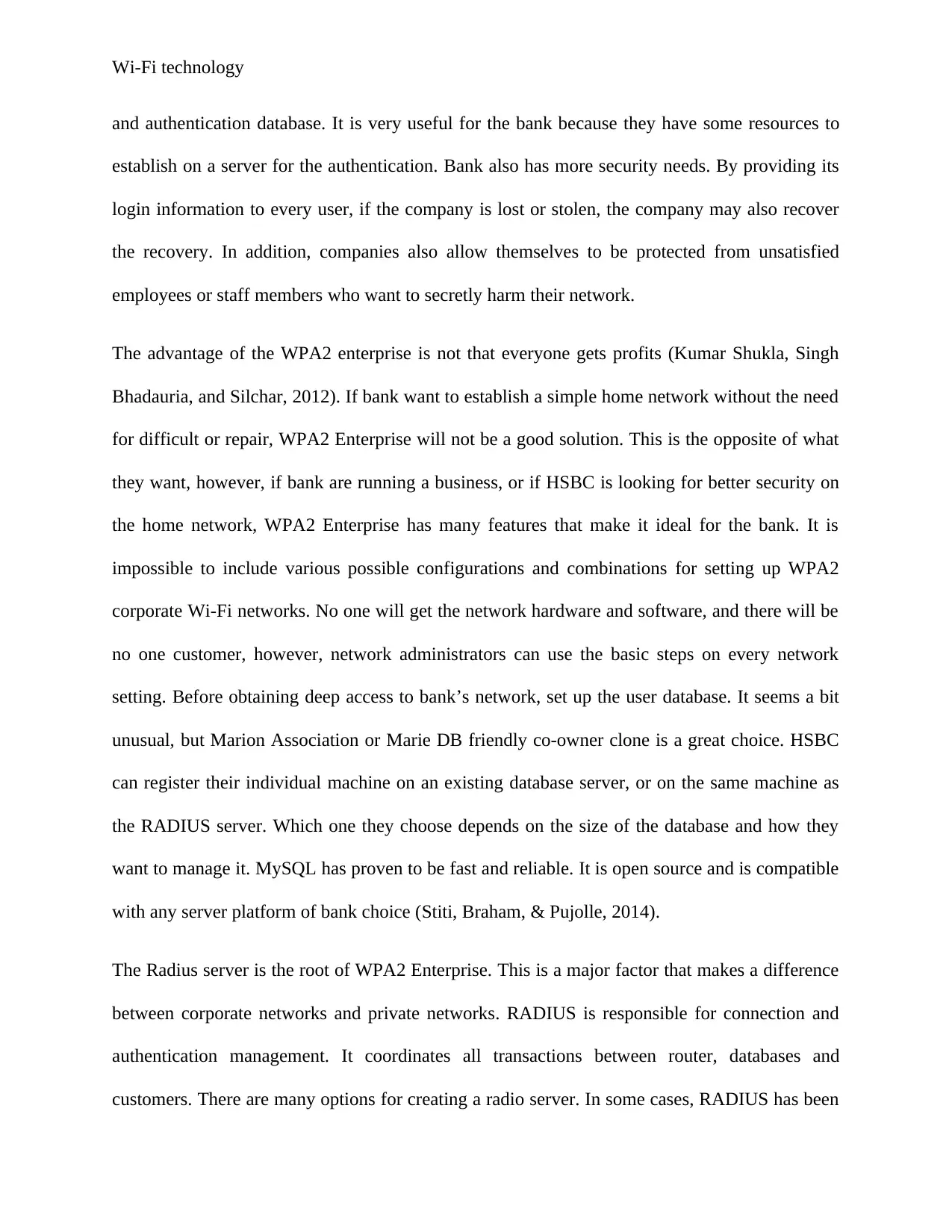
Wi-Fi technology
and authentication database. It is very useful for the bank because they have some resources to
establish on a server for the authentication. Bank also has more security needs. By providing its
login information to every user, if the company is lost or stolen, the company may also recover
the recovery. In addition, companies also allow themselves to be protected from unsatisfied
employees or staff members who want to secretly harm their network.
The advantage of the WPA2 enterprise is not that everyone gets profits (Kumar Shukla, Singh
Bhadauria, and Silchar, 2012). If bank want to establish a simple home network without the need
for difficult or repair, WPA2 Enterprise will not be a good solution. This is the opposite of what
they want, however, if bank are running a business, or if HSBC is looking for better security on
the home network, WPA2 Enterprise has many features that make it ideal for the bank. It is
impossible to include various possible configurations and combinations for setting up WPA2
corporate Wi-Fi networks. No one will get the network hardware and software, and there will be
no one customer, however, network administrators can use the basic steps on every network
setting. Before obtaining deep access to bank’s network, set up the user database. It seems a bit
unusual, but Marion Association or Marie DB friendly co-owner clone is a great choice. HSBC
can register their individual machine on an existing database server, or on the same machine as
the RADIUS server. Which one they choose depends on the size of the database and how they
want to manage it. MySQL has proven to be fast and reliable. It is open source and is compatible
with any server platform of bank choice (Stiti, Braham, & Pujolle, 2014).
The Radius server is the root of WPA2 Enterprise. This is a major factor that makes a difference
between corporate networks and private networks. RADIUS is responsible for connection and
authentication management. It coordinates all transactions between router, databases and
customers. There are many options for creating a radio server. In some cases, RADIUS has been
and authentication database. It is very useful for the bank because they have some resources to
establish on a server for the authentication. Bank also has more security needs. By providing its
login information to every user, if the company is lost or stolen, the company may also recover
the recovery. In addition, companies also allow themselves to be protected from unsatisfied
employees or staff members who want to secretly harm their network.
The advantage of the WPA2 enterprise is not that everyone gets profits (Kumar Shukla, Singh
Bhadauria, and Silchar, 2012). If bank want to establish a simple home network without the need
for difficult or repair, WPA2 Enterprise will not be a good solution. This is the opposite of what
they want, however, if bank are running a business, or if HSBC is looking for better security on
the home network, WPA2 Enterprise has many features that make it ideal for the bank. It is
impossible to include various possible configurations and combinations for setting up WPA2
corporate Wi-Fi networks. No one will get the network hardware and software, and there will be
no one customer, however, network administrators can use the basic steps on every network
setting. Before obtaining deep access to bank’s network, set up the user database. It seems a bit
unusual, but Marion Association or Marie DB friendly co-owner clone is a great choice. HSBC
can register their individual machine on an existing database server, or on the same machine as
the RADIUS server. Which one they choose depends on the size of the database and how they
want to manage it. MySQL has proven to be fast and reliable. It is open source and is compatible
with any server platform of bank choice (Stiti, Braham, & Pujolle, 2014).
The Radius server is the root of WPA2 Enterprise. This is a major factor that makes a difference
between corporate networks and private networks. RADIUS is responsible for connection and
authentication management. It coordinates all transactions between router, databases and
customers. There are many options for creating a radio server. In some cases, RADIUS has been
⊘ This is a preview!⊘
Do you want full access?
Subscribe today to unlock all pages.

Trusted by 1+ million students worldwide
1 out of 18
Related Documents
Your All-in-One AI-Powered Toolkit for Academic Success.
+13062052269
info@desklib.com
Available 24*7 on WhatsApp / Email
![[object Object]](/_next/static/media/star-bottom.7253800d.svg)
Unlock your academic potential
Copyright © 2020–2025 A2Z Services. All Rights Reserved. Developed and managed by ZUCOL.




